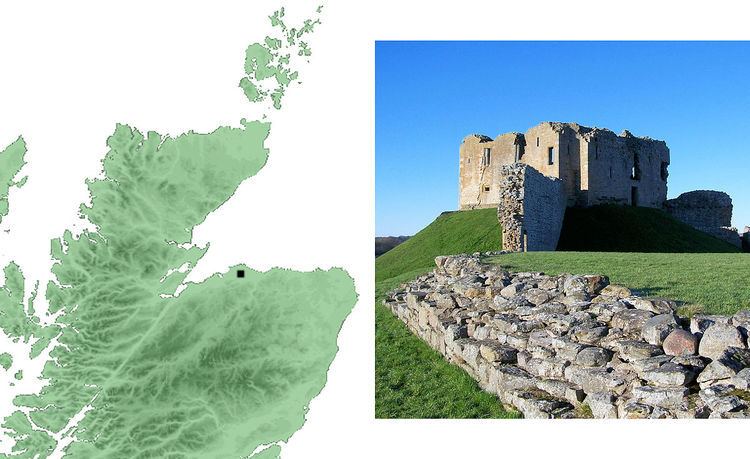Open tothe public Yes — No entry fee Built c. 1140 & 1305 | Condition Ruined In use c.1140 to 1705 Phone +44 1667 460232 | |
 | ||
Type First castle: wood - Motte-and-baileySecond castle: stone - keep with curtain wall Hours Open today · Open 24 hoursTuesdayOpen 24 hoursWednesdayOpen 24 hoursThursdayOpen 24 hoursFridayOpen 24 hoursSaturdayOpen 24 hoursSundayOpen 24 hoursMondayOpen 24 hours Similar Spynie Castle, Elgin Cathedral, Balvenie Castle, Brodie Castle, Pluscarden Abbey | ||
Duffus castle 2015
Duffus Castle, near Elgin, Moray, Scotland, was a motte-and-bailey castle and was in use from c.1140 to 1705. During its occupation it underwent many alterations. The most fundamental was the destruction of the original wooden structure and its replacement with one of stone. At the time of its establishment, it was one of the most secure fortifications in Scotland. At the death of the 2nd Lord Duffus in 1705, the castle had become totally unsuitable as a dwelling and so was abandoned.
Contents
Duffus castle
The wooden castle
Moray was an important part of the Pictish confederation. At the beginning of the 12th century the province was ruled by the mormaer, Angus, grandson of Lulach Macgillecomgan, who had succeeded Macbeth as King of Scots in 1057. Ferociously autarchic and highly distrustful of the expansion of the monarchy, Angus rebelled in 1130. The revolt was resolutely quashed by King David I,who immediately began to populate the province with nobles and people of his own choosing.
Freskin
One significant arrival was Freskin (also known as Freskyn), who already owned an extensive estate in Lothian (Strabrock, now Uphall). He accepted lands at Duffus from King David I of Scotland. Freskin’s background is uncertain. The historical consensus amongst historians is that he was of Flemish background, the principal argument being that "Freskin" is a Flemish name. Undoubtedly, King David, himself a Normanized magnate with extensive estates in northern England and Normandy, granted lands to many nobles from Flanders as well as Normans. The unlikely alternatives are that he may have been an Anglo-Saxon or a Scot who fought for King David and his English general Edward Siwardsson in Moray. At that time, when Flemish nobles were referred to in writs by nationality (almost never), they were styled "Flandrensis". Freskin appears in no contemporary sources, and was never referred to by his national origin. By the 13th century his descendents were referring to themselves as 'de Moravia' ('of Moray') and had become one of the more powerful families in northern Scotland.
It was Freskin who built the great earthwork and timber motte-and-bailey castle in c. 1140 on boggy ground in the Laich of Moray. It was certainly in existence by the time the king came to visit in 1151. The motte was a man-made mound with steeply sloping sides and a wide and deep ditch that surrounded the base. Timber buildings would have stood on its flat top and would have been further protected by a wooden palisade placed around the edge of the summit. The motte was accessed from the bailey. This is a wide stretch of earth elevated above the surrounding area but not as high as the motte. At Duffus, the motte would have been reached by steps set into the mound. The bailey contained the buildings necessary to sustain its inhabitants – brew and bake houses, workshops and stables – as well as the living accommodation.
The castle was destroyed in 1297 during a rebellion against English rule in the region.
The stone castle
Freskin’s direct line ended in 1270 and the castle passed into the ownership of Sir Reginald le Chen (d.1312) through marriage to the heiress Mary, daughter of Freskin de Moravia. With the death of Reginald le Chen of Duffus in 1345 Duffus passed to his daughter Mariot who was married to Nicholas, the second son of the 4th Earl of Sutherland. The Sutherlands, themselves were descended from Freskyn and remained in their possession until 1705 when the castle was abandoned.
In 1305, it was recorded that Reginald le Chen received a grant from King Edward I of England of 200 oaks from the royal forests of Longmorn and Darnaway "to build his manor of Dufhous" demonstrating that a large construction project was being carried out. The wood would have been needed for scaffolding, flooring and roofing of the new stone fortress.
A two-storey rectangular tower was built on the motte and was the main residence. The first floor held the lord's hall, with a latrine and bed chambers. The ground floor was the main storage space and also accommodated the lord’s household. The tower was built as a defensive structure with a small number of narrow windows. There was only the one entrance on the ground floor which also housed a portcullis. On the second floor, two doors exited onto the walkway of the curtain wall. This wall completely enclosed the bailey. The put-log holes built into the curtain wall indicate the presence of a number of buildings. On the north side a later building was erected that housed a kitchen, a great hall with reception room and the great chamber bedroom. It is possible that this building was constructed by the Sutherlands. It is not known when the serious subsidence took place but evidence of repairs to the tower are evident before it slid down the motte. The tower shows no further repairs and may have collapsed early on but the newer hall became the main residence. This building shows continued alterations over time. In 1689, John Graham, 1st Viscount of Dundee was a guest of Lord Duffus just before the battle of Killiecrankie and would be one of the last important visitors before the castle’s abandonment.
